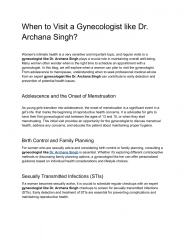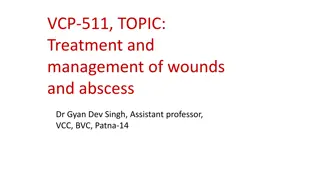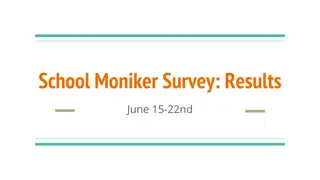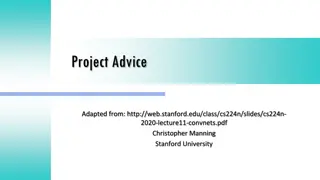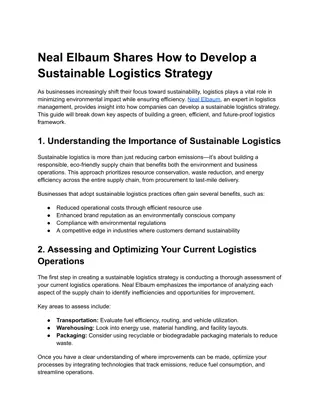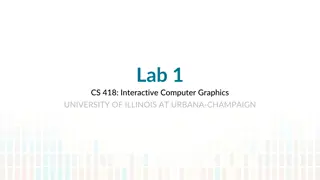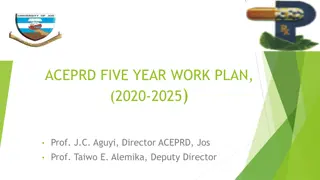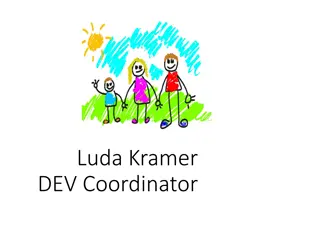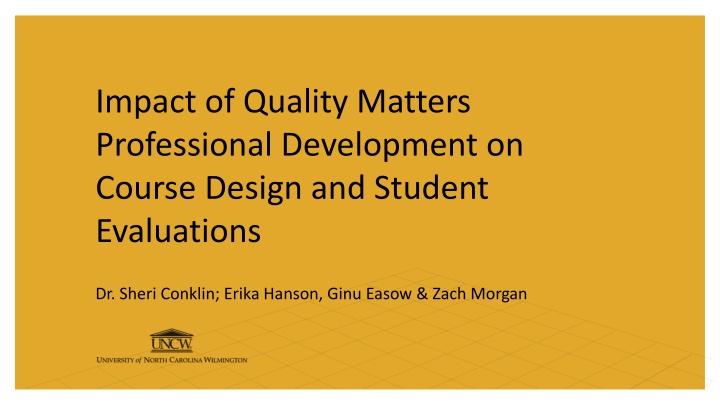
Impact of Quality Matters Professional Development on Course Design and Student Evaluations
Explore the impact of Quality Matters professional development on course design and student evaluations through a research study at UNCW. The study aims to uncover changes in course design, student evaluations, and the overall effectiveness of the Quality Matters approach.
Download Presentation

Please find below an Image/Link to download the presentation.
The content on the website is provided AS IS for your information and personal use only. It may not be sold, licensed, or shared on other websites without obtaining consent from the author. If you encounter any issues during the download, it is possible that the publisher has removed the file from their server.
You are allowed to download the files provided on this website for personal or commercial use, subject to the condition that they are used lawfully. All files are the property of their respective owners.
The content on the website is provided AS IS for your information and personal use only. It may not be sold, licensed, or shared on other websites without obtaining consent from the author.
E N D
Presentation Transcript
Impact of Quality Matters Professional Development on Course Design and Student Evaluations Dr. Sheri Conklin; Erika Hanson, Ginu Easow & Zach Morgan
At UNCW UNCW APPQMR Course Design
Research Questions 1) Does QM professional development have an impact on course design? 2) What types of changes are made as a result of developing expertise with the QM approach? 3) How does course design impact student evaluations?
Participants 65 potential participants 15 peer review 6 viable participant 3 final participants
Exploratory Case Study Application of QM workshop to course design Course design 3 1 2
Data Collection Content Analysis
Quality Matters Clusters Eight QM Clusters 1. Clarity of Purpose 2. Ease of Use 3. Course Alignment 4. Learner Engagement 5. Accessibility Standards 6. Knowledge Acquisition 7. Compliance 8. Learner Support Legon, R. (2015). Measuring the impact of the Quality Matters Rubric: A discussion of possibilities. American Journal of Distance Education, 29(3), 166-173.
Quality Matters Clusters Learner Support QM Specific Standards 1.8 1.9 Self-introduction Learner introduction 3.5 5.2 6.2 6.3 Opportunity to track progress Active learning Tools promote engagement Variety of technology
Cluster Index Cluster Index=Initial Cluster Score Cluster Score Post Revision
Data Collection Content Analysis Instructor interviews Student Evaluations
QM Clusters and Student Evaluations Alignment Student Evaluation Crosswalk Learner Support Student Evaluation Crosswalk Q1 answer questions Q9 Encouraged use of multiple resources Q20 Encouraged student- instructor interaction Found ways to help students Q6 fit into the course Q10 Explained course material clearly and concisely Made it clear how each topic
Limitations Exploratory case study Small sample Variation in student evaluation response rate Natural disaster Update from 5th to 6th edition of QM rubric Student evaluation classification to QM clusters
Course One Findings Spring 2015 Spring 2016 Spring 2017 . . . gives you a little more clarity, understanding how the course looks from the student point of view and tweaking it to make it clearer. My goal is to get almost no emails about little confused things, confusing about the assignment . . .
Course One Findings 2015 - I feel that this course is definitely in need of some streamlining. The assignments were listed in an illogical, unnecessarily complicated way. 2017 - [Professor] has done an excellent job designing this course. . .
Course Two Findings Spring 2017 Spring 2018 Fall 2018 . . . I made some changes that I can make quickly before a ... you know, I don't particularly like to make huge changes right before a semester. But if I have time, I'll change what I can. I typically, when I redo bigger courses, or need to do a larger overhaul, I'll do it during the summer.
Course Two Findings Spring 2017 - I appreciate the clarity and the depth with which he teaches Spring 2018 - . . . always responding to emails and questions in a timely manner.
Course Three Findings Spring 2017 Fall 2017 Fall 2018 It's just forced me, I think, to really think of ways to meet those requirements, those kind of transparent things, but also not make it too, frankly, off-putting. In doing that, I think it's forced me to reexamine what I teach and how I teach because I've been doing it for a really, really, really long time, so in that sense, it was nice to get a refresh. . . .
Course Three Findings Spring 2017 - Communicates well and responds to emails quickly. Fall 2018 - . . . was very organized and helpful throughout the course.
Research Question 1 Does QM professional development workshops have an impact on course design?
Research Question 2 What types of changes are made as a result of developing expertise with the QM approach? Ease of Use, Learner Engagement, and Learner Support Minimal changes to Knowledge Acquisition
Research Question 3 How does course design impact student evaluations? QM revisions not directly linked to student evaluations No patterns among courses with student evaluations Qualitative data from Student Evaluations referenced instructor social presence
Next Steps Expand current study Application of QM workshop to course design Course design 75 potential faculty
Next Steps Incorporate Community of Inquiry (CoI) into research study Cognitive Presence Social Presence Teaching Presence
Next Steps QM Research aligning with student outcomes
Brinkley-Etzkorn, K. E. (2018). Learning to teach online: Measuring the influence of faculty development training on teaching effectiveness through a TPACK lens. The Internet in Higher Education, 38, 28-35. Chen, K., Lowenthal, P. R., Bauer, C., Heaps, A., & Nielson, C. (2017). Moving beyond smile sheets: A case study on the evaluation and iterative improvement of an online faculty development program. Online Learning, 21(1), 85-111. Kearns, L., & Mancilla, R. (2017). The impact of Quality Matters professional development on teaching across delivery formats. American Journal of Distance Education, 31(3), 185-197. Legon, R. (2015). Measuring the impact of the Quality Matters Rubric: A discussion of possibilities. American Journal of Distance Education, 29(3), 166-173. Roehrs, C., Wang, L., & Kendrick, D. (2013). Preparing faculty to use the Quality Matters model for course improvement. Journal of Online Learning and Teaching, 9(1), 52-67. Shattuck, J., Dubins, B., & Zilberman, D. (2011). MarylandOnline s interinstitutional project to train higher education adjunct faculty to teach online. International Review of Research in Open and Distance Learning, 12(2), 40-61. Yang, D. (2017). Instructional strategies and course design for teaching statistics online: Perspectives from online students. International Journal of STEM Education, 4(34), 1-15.


